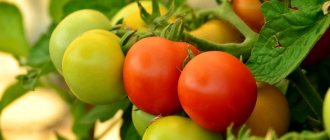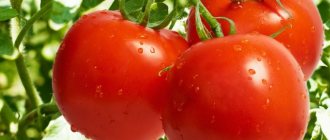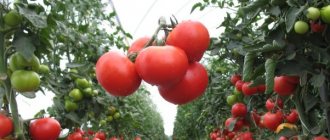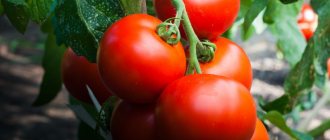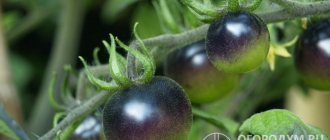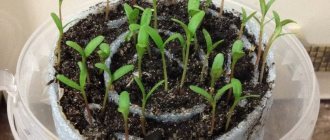Author's rating
Author of the article
Yakov Pavlovich
Professor, Head of the Department of Vegetable Growing
Articles written
153
When buying tomato seeds at a garden store, gardeners often come across the word “beef” on the bag. What are these “beef tomatoes” and how are they different from the usual varieties? This marking of seed material is common in the USA and Europe. The fruits are consumed fresh, baked and fried along with grilled meat.
Beef tomatoes: characteristics and features
The term “beef” means that the seeds will grow into plants with fleshy, multi-chambered, large fruits. The content of juice and seeds in tomatoes is minimal. Beef tomatoes have the following qualities:
- fetal weight from 150 to 600 g;
- the presence of more than 4 small seed chambers;
- the pulp is dense, holds its shape well when cut into circles or slices;
- Beef tomato can be stored for no more than 5–7 days.
Tomatoes have a rich, sweet taste. Some varieties have fruity notes in taste. The color of the skin of the fruit can be different: red, pink, yellow, chocolate.
Distinctive features
The name “beef” is translated from English as “meat, beef.” This is probably a hint at the volume of tomatoes, each fruit of which looks fleshy and has more weight compared to other varieties.
However, in addition to size, there are a number of other distinctive features of “meat” varieties:
- Almost all large-fruited varieties are interdeterminate. Their growth is almost unlimited, and in conditions of high humidity and plenty of nutrients in the soil, they form a very tall and spreading bush. That is why they require pinching and pinching so that all the strength does not go into the green mass.
- Fruit weight - from 150 grams. This is the minimum weight that allows the variety to be classified as a “beef” variety. In fact, many crops produce tomatoes that weigh 500, 600 and even 1.5 kg! True, this requires a confluence of several favorable circumstances and compliance with all agrotechnical practices.
- Due to the large size of the fruits and large bush, most species are classified as mid- and late-ripening, since it takes a lot of time for all parts to fully ripen, and time is also spent on transporting nutrients.
- A cross section shows that there are more than two seed chambers. At the same time, there are few seeds themselves, and the pulp between the seed chambers is powerful and takes up a lot of space.
- The inside of tomatoes is grainy, the pulp contains more sugars and dry matter in percentage terms.
- Externally, beef tomatoes are predominantly flattened, round or heart-shaped, elongated and pear-shaped are not found, the upper part near the petiole is always massive.
- The skin is most often thin, which makes tomatoes poorly suited for transportation and preservation. Their scope of application is direct consumption.
- The color of the fruit is red, pink, rarely yellowish or slightly dark.
- The fruits are most often ribbed, the ribs can be weakly or moderately expressed, a completely smooth and round shape is rare.
What kind of tomatoes do you grow in your garden?
StandardBeef
Main advantages
The main advantage of fleshy large-fruited tomatoes is their taste and high pulp content inside the fruit. These tomatoes are delicious fresh in salads. You can put them on sandwiches without fear that the juice will leak through the bread. Different varieties have their own taste of fruit: sweet (sugar), melon, pear, watermelon.
The fleshy fruits make delicious ketchup, tomato paste and various sauces. The yield of the finished product is higher than that of a prepared dish from ordinary tomatoes.
Expert opinion
Stanislav Pavlovich
Gardener with 17 years of experience and our expert
Ask a Question
In terms of dry matter content, carotene, lycopene and sugars, beef tomatoes have no competitors.
History of creation
Tomatoes, which have very large and fleshy fruits, were bred in the USA.
In a country where grilling meat and vegetables is well developed, there was an urgent need to create tomatoes with low-juiciness, fleshy fruits. The creator of these plants is considered to be Johan Munstr, a farmer and vegetable grower. Munster received an award from the government for his brainchild. Today, there are dozens of varieties and hybrids of beef tomatoes known in the world, which are grown in greenhouses and open ground.
Large tomatoes
Interesting! Translated from English, the word “beef” can be translated as beef, steak.
The name fully characterizes the structure of the fruit of this type of tomato. The flesh of the beef fruit is red, fleshy, with many seed chambers. At the same time, the seeds are small and there is very little juice inside the fruit. When cut, the structure of a beef tomato resembles a piece of marbled beef.
Fleshy tomato in section
.u48ae4fd6e790081f4e6a580450a0f6f5.u48ae4fd6e790081f4e6a580450a0f6f5:active,.u48ae4fd6e790081f4e6a580450a0f6f5:hover.u48ae4fd6e790081f4 e6a580450a0f6f5.u48ae4fd6e790081f4e6a580450a0f6f5 .ctaText.u48ae4fd6e790081f4e6a580450a0f6f5 .postTitle.u48ae4fd6e790081f4e6a580450a0f6 f5:hover .postTitle
Are there any disadvantages?
The fruits of “beefsteak” tomatoes are endowed with thin and delicate skin that is easy to damage. Because of this, the fruits must be transported with extreme caution.
The fruits of this variety can be stored for no more than a week, even in the refrigerator. The harvested crop must be processed or eaten within 3–5 days.
During the growing process, plants that form a harvest of large-fruited tomatoes require special shaping (normalization of the ovaries) and an enhanced diet.
Pests and diseases
Most modern plants are, to one degree or another, resistant to major tomato diseases. Large-fruited varieties, having thin skin, are prone to cracking. An infection penetrates into the wounds, which leads to the development of rot. To avoid cracking, take the following measures:
- reduce watering during the final fruit filling phase;
- remove cracked tomatoes in a timely manner and ripen them indoors, sprinkling the cracks with salt;
- spray the plants with antifungal drugs.
The best varieties and their descriptions
Domestic gardeners successfully grow not only foreign varieties of large-fruited tomatoes, but also plants of Russian selection. Hybrids bred in Russia are more unpretentious to growing conditions.
Yummy beef f1
A hybrid variety of large-fruited tomato with red skin. The plant is formed into a single stem, which reaches a height of 170 cm. The harvest is formed in clusters, 5-6 fruits each, weighing from 230 g (individual tomatoes can weigh 400 g!).
The fruit is round, slightly flattened, with slight ribbing. There is a tiny nose visible at the top of the tomato. The interior is multi-chambered, low-juicy. The pulp is sugary, dense, tasty.
The hybrid is recommended for growing in open and protected ground. The yield in a greenhouse can reach 18 kg per 1 sq. m.
Mona beef f1
Medium-early tall hybrid for film and polycarbonate greenhouses. The first fruits ripen 98–100 days after the sprouts appear. The height of the bush reaches 170 cm.
See also: The best varieties of tomatoes for the Leningrad region
The weight of tomatoes exceeds half a kilo, and specimens weighing 700 g are not uncommon. Due to the large weight of the fruits, it is recommended to leave no more than 3 of them in a cluster, and additionally tie the clusters to a trellis.
The color of the skin and pulp is dark red. The taste is sweet, rich. The pulp is dense.
The yield of tomatoes per plant is 5–6 kg.
Big sasher
A hybrid of tall tomato with relatively small fruits, weighing 150 g. The harvest ripens 95 days after germination or 100 days after planting. Stem height up to 270 cm. It is recommended to grow indoors.
The fruits are round and regular in shape. The skin is dark brown, durable. The taste is sweet, the flesh is dense.
Beef porter f1
Large-fruited hybrid f1 of medium ripening period. The height of the plant does not exceed 1 m, which makes it suitable for growing in open ground.
The fruits are round, slightly ribbed, and impressive in size – some weigh more than 1.5 kg. The usual weight of a tomato is 700–1000 g. The skin color is red, the flesh is tender, sweet and sour.
Beef master
Dutch hybrid from the group of beefsteak tomatoes. The stem rises to a height of 170–190 cm, up to 9 clusters are formed on it, each containing 4–5 tomatoes. The harvest begins 110 days after germination.
The fruits are red, round. Their weight ranges between 250 and 800 g, with an average weight of 400–500 g. The pulp is sweet and dense, with a small number of seeds.
Expert opinion
Stanislav Pavlovich
Gardener with 17 years of experience and our expert
Ask a Question
The hybrid is suitable for growing in greenhouses and open ground (in the southern regions). The plant tolerates heat well, the fruits do not crack. Productivity up to 16 kg per 1 sq. m in a greenhouse.
Negro beef
A hybrid for salad purposes, with a tomato weight of 300 g. The plant grows up to 250 cm, so gartering to a trellis is required. Recommended for placement in greenhouses and greenhouses in the middle zone and in open ground in the south.
Tomatoes are round in shape, beautiful chocolate in color. The pulp is very sweet, sugary, aromatic. Up to 7 kg of fruits are removed from the bush.
Big Tasty f1
The hybrid forms a bush, 180–200 cm high. The plant can be planted in greenhouses and outdoors, tied to a trellis. The harvest ripens 120 days after sowing.
Expert opinion
Stanislav Pavlovich
Gardener with 17 years of experience and our expert
Ask a Question
The fruits are red, flat-round, with slight ribbing, weighing 220–300 g. The pulp is tender, juicy, and sweet.
Large-fruited tomatoes
Because of their fleshy flesh, large tomatoes are nicknamed beef tomatoes. These include fruits whose weight exceeds 150 grams. The largest officially registered fruit grown in Russia weighed 1.5 kg. Part of the large-fruited group, tomatoes can be grown in open and closed ground. They differ in ripening time, yield, disease resistance and taste.
Advantages and disadvantages
The main advantage of the fruits, for which they are especially valued, is their juicy, fleshy pulp. This group of tomatoes includes varieties that have different colors. It can be red, green, yellow, white and brown. Fruits can have the following shape: round, oval, ribbed, pear-shaped, pepper-shaped, etc.
The fruit has a sweet taste and thin skin. There are a small number of seed chambers inside the fruit. Tomatoes are characterized by high yields and have an attractive presentation. Gardeners grow large tomatoes for personal consumption and for commercial purposes.
The main disadvantage of beef tomatoes is their high care requirements and increased sensitivity to lack of mineral nutrition. The bushes of the plant protect from drafts and strong winds. Most varieties have late ripening periods. Large fruits are not suitable for preservation. When marinating tomato halves, they quickly fall apart in the brine.
Features of cultivation
When choosing a method for planting beef tomatoes, you must remember that they ripen when planted in open ground only in regions with a warm climate and long summers. The bushes of the plant need special shaping and staking. Plants are demanding on lighting and air temperature.
Expert opinion
Filatov Ivan Yurievich, private farmer for more than 30 years
The soil in the beds with tomatoes should have an acidity no higher than pH 6.5. The soil must be mixed with river sand, peat, wood ash and compost. It must have good air tightness.
Features of planting and care
Large-fruited tomatoes are more capricious to grow than ordinary varieties. Most beef tomatoes are tall, so staking with stakes or a trellis is required. To obtain a stable harvest, plants are grown in a greenhouse, providing them with regular watering and fertilizing.
Growing by seeds
Plants for planting in a greenhouse are sown in February - early March for seedlings. Store-bought hybrid seeds are already treated for disease and are often coated with fertilizer. They do not require additional processing.
Dry seeds are lowered to a depth of 7–9 mm, placing 1 seed in a separate pot with a volume of 250–300 ml. The substrate for tomatoes should consist of humus, peat, sand and garden soil, taken in equal parts.
Important! When making the mixture yourself, you need to disinfect it. The soil is steamed or spilled with “Fitosporin”, a solution of potassium permanganate.
The seedlings are kept in a bright room, maintaining a temperature of +18 degrees at night and +23 degrees during the day. Water the tomatoes sparingly with warm water.
See also: Features of growing tomatoes in a snail by Yulia Minyaeva
At the age of 3–4 true leaves, the seedlings are transplanted into pots with a capacity of 1 liter. After transplantation, the tomatoes are fed with complete mineral fertilizer (Kemira, Agricola, Gera).
Expert opinion
Stanislav Pavlovich
Gardener with 17 years of experience and our expert
Ask a Question
Seedlings are planted in a permanent place at the age of 55–60 days. The plants are watered abundantly beforehand. The layout of beef tomatoes is 60 by 70 cm. The surface of the ground after planting is mulched with sawdust, grass or tree bark, in a layer of 10 cm. Mulch protects the soil from drying out and overheating, and suppresses the development of weeds.
How to care for such tomatoes
Beefsteak tomatoes are formed into 1-2 stems, tying the plant to a strong trellis. A tomato develops at a temperature of +20...+25 degrees; at low temperatures, plant growth stops; at high temperatures, the pollen becomes sterile.
Tall tomatoes require watering and fertilizing. During the growth of tops, flowering and fruiting, the bushes are watered every 3–4 days, spending 10–15 liters per plant. From the moment the tomatoes turn red, watering is reduced to once a week.
The “beefs” are fed every 3 weeks, starting from the moment of picking. Use mineral fertilizers with a predominance of potassium (potassium sulfate, Agricola, Good Power).
To obtain very large specimens of fruit, the ovaries are normalized. No more than 3 (usually 1–2) tomatoes are left on each bunch, the rest are removed. All lower leaves are also removed from the stem so that the bushes are better ventilated.
Expert opinion
Stanislav Pavlovich
Gardener with 17 years of experience and our expert
Ask a Question
Advice. To prevent the bases of the hands from breaking under the weight of the fruit, they are additionally tied up.
Harvesting is carried out weekly.
Productivity and use of fruits
In greenhouse conditions, up to 18 kg of tomatoes are harvested from each square meter. In open ground the result is more modest - about 9 kg.
Beef tomatoes are eaten fresh, placed on sandwiches and made into salads with sweet fruits. The meatiness of “beefs” allows them to be used in the preparation of vegetable stews and sauces. When fried and stewed, tomato pieces yield little juice.
Growing Tips
What variety of tomatoes do you prefer to grow?
LargeMedium
- Experts recommend forming bushes of indeterminate varieties into 1-2 stems. This will allow you to get the maximum possible yield from the plant and not overload the bush with fruits. Bushes are pruned at least once a week. During this time, the shoots of the plant grow by 3-5 cm.
- Feeding tomatoes must be carried out during the period of flowering and fruit formation. Microclimate and watering are important for tomatoes. Lack of moisture slows down the growth of fruits, impairs their taste and leads to their shedding
Disease resistance
One of the main advantages of the Big Beef F1 tomato variety is its high resistance to “tomato” diseases. These are fungal diseases - verticillium and fusarium wilt, cladosporiosis, gray leaf spot, stem Alternaria, parasitic disease root-knot nematode, tobacco mosaic virus.
Another advantage of the variety is that it is not afraid of low temperatures. Hybrid Big Beef is a very good solution for preparing fresh salads, excellent vegetable side dishes for meat dishes and for processing into winter preparations. It certainly deserves the attention of Russian gardeners.
| Late ripening | Early ripening | Mid-late |
| Bobcat | Black bunch | Golden Raspberry Miracle |
| Russian size | Sweet bunch | Abakan pink |
| King of Kings | Kostroma | French grape |
| Long Keeper | Brawler | Yellow banana |
| Grandma's gift | Red bunch | Titanium |
| Podsinsky miracle | The president | Slot |
| American ribbed | Summer resident | Krasnobay |
Farmers' reviews about tomatoes
Reviews of the Big Beef tomato and its brethren are mostly positive. Tomatoes are grown for personal use, for sale in fresh and cooked form.
Experienced farmers willingly share tips on growing varieties:
- Varieties grow best in light soils.
- It is best to water plants in hot weather in the morning or a few hours before sunset.
- The amount of watering of seedlings before planting in the ground should be increased.
- When grown in a greenhouse, it must be ventilated after each watering to prevent excess greenhouse effect.
Some farmers managed to grow Big fruits weighing up to 1.5 kg. To achieve such results, you need to leave only 2-3 ovaries. It is also important to increase the intensity of feeding.
Beefsteak tomato varieties are fun to grow. There is excitement to get larger fruits. They have a number of advantages and advantages over other varieties. Tomato Big Beef F1 deserves the attention of farmers.
Description of the Pink variety
The beefsteak tomato Pink was bred agro. There is another popular variety of Pink Brandy. Both varieties belong to the first generation hybrids.
The varieties have the following general characteristics:
- The bush is compact, the leaves grow densely.
- The ripening period is mid-early. The fruits ripen unevenly.
- The yield is high - 25 kg per square meter of bed.
- High resistance to low temperatures and droughts.
- High resistance to bronze virus, fusarium, and vercillosis.
Based on reviews from gardeners, it can be judged that the plant takes root well in the middle zone. Yield indicators do not suffer. Pink is unpretentious in care.
Characteristics of Beef Pink fruits
Beef Pink tomato fruits are pink in color. They are dense, multi-chambered, have a rounded shape and a ribbed surface. The average weight of one Pink tomato is about 300 grams.
The taste of the fruit is moderately sweet. They are best consumed fresh. But Pink tomatoes have a universal purpose, so they are widely used in cooking.
The transportability of the variety is high. Tomatoes are quite dense, so they easily retain their shape. Due to its high yield and resistance to disease, it is very profitable to grow Pink for sale.
Characteristics of the variety
The variety was included in the State Register of Breeding Achievements, approved for use, in 2008. The first one was registered in Holland in 2001. It is recommended to grow Big Beef indoors:
- in Central;
- Northern;
- Northwestern;
- Middle Volga;
- Volga-Vyatka region.
Its distribution does not limit recommendations; Big Beef is growing successfully:
- in the Urals;
- in Siberia;
- in the Far East.
The tomato yield is high - about 9 kg per square. The ripening period after planting seedlings is 73 days. If you want to plant on a larger scale, then consider growing Sprut tomatoes, of course, it is not an easy task, but will allow you to harvest 1 ton or more. Big Beef tomatoes are high-yielding and more suitable for cultivation in temperate climates.
Varieties of beefsteak tomatoes
Beef tomatoes include all varieties whose fruits weigh more than 150 g. Today, the variety of varieties is very large. Varieties differ in terms of ripening and color of tomatoes. The general characteristics of beefsteak tomatoes are high yield and unpretentiousness.
The most popular varieties are:
- tomato Big Beef F1;
- Beef Pink F1;
- Pink Brandy F1;
- Rosebeef F1;
- Porter;
- The president;
- Mona F1;
- Negro;
- Master;
- Bifseller gold, red.
F1 in the name of the variety means that it is a first generation hybrid. Beefsteak hybrids were bred by breeders from Holland, the USA, Russia and Ukraine.
